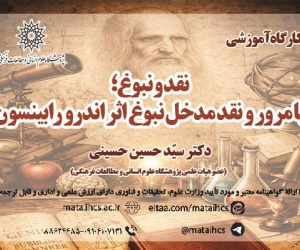تأثیرپذیری در موسیقی عاشیقی ترکان قشقایی (مقاله علمی وزارت علوم)
درجه علمی: نشریه علمی (وزارت علوم)
آرشیو
چکیده
قشقایی ها مهاجرانی بوده اند که از مناطق مختلف به جنوب ایران آمده اند. در گذشته جامعه ی قشقایی جامعه ای طبقاتی بود و خاندان ایل خانی در رأس این نظام طبقاتی قرار داشت. موسیقی همواره در تمام طبقات اجتماعی ایل قشقایی حضور داشته است. کارگان عاشیق ها یکی از پنج کارگانِ فرهنگ موسیقایی قشقایی ست که تحولات بسیاری را تجربه کرده است؛ تغییراتی در سازبندی، تغییر فرم اجرا و تضعیف کارگان که در نهایت به از میان رفتن این سنت موسیقایی انجامید. عاشیق ها که در فرودست ترین طبقات اجتماعی ایل جای داشتند با حمایت ایل خانان به قوم قشقایی پیوستند و هنر خود را ارتقاء بخشیدند؛ در نهایت نیز با از میان رفتن نظام ایل خانی، سنت موسیقایی آنها نیز رو به انحطاط رفت. اغلب تأثیرپذیری ها و تغییرات حاصل از آن در موسیقی عاشیقیْ ریشه در نظام طبقاتی ایل دارند. تغییرات ایجادشده در این موسیقی نیز غالباً با حضور افرادی از طبقات بالای اجتماع همراه بوده که پذیرشِ مرجعیت این طبقات توسط مردمْ پذیرشِ تغییرات را نیز به همراه داشته است. این پژوهش که به معرفی موسیقی عاشیقی قشقایی و بررسی تأثیرپذیری در این کارگان می پردازد بر اساس کار میدانی در مناطق قشقایی نشین و گفت وگو با موسیقیدانان قشقایی به انجام رسیده و هدف از آن معرفی و بررسی تغییراتِ حاصل از برخوردهای فرهنگی، تغییر شرایط زندگی، شهری شدگی و تجددگرایی قشقایی ها در این موسیقی است.Âshiq in the Musical Culture of Qashqâyi Turks Investigating the Acculturation
Qashqâyis were nomads who migrated to the southern region of Iran and formed a single ethnic group; a tribe consisting of Turks, Kurds, Lors and Arabs. Since the majority of this tribe were Turks, the main language of the Qashqâyis was Turkish, from the Caucasian Turkish language root. The provinces of Isfahan, Chahar Mahall Bakhtiari, Kohkiluyeh and Boyer-Ahmad, Khuzestan, Bushehr and most importantly, Fars constitutes the Qashqâyi regions of Iran. In the past, the Qashqâyi society was a hierarchical society consisting of different social classes and the Ilkhâni family was at the head of this hierarchical system, and led the tribal affairs, thus distinguishing this tribe from others. In this hierarchical system, musicians were placed in the lowest social classes. Music has always been present in all social classes of the Qashqâyi tribe. Qashqâyi musicians include Âshiqs, Changis, Sârebâns, non-professional musicians, and women, each of whom, have their own repertoires. The Âshiqs's repertoire is one of the five repertoires of the Qashqâyi musical culture that has undergone many changes. The Âshiqs migrated to Fars from the north-west regions and joined the Qashqâyi tribe. They, who were from the lowest social classes, joined the Qashqâyi tribe. With the support of the Ilkhâns, the Ashiqs improved their art and made changes in their repertoire. Eventually, with the disappearance of the Ilkhâni system, this musical tradition also declined. The Âshiqs performed music and were financially supported by the Ilkhâns. In fact, the musical life of the Âshiqs depended on the presence of the Ilkhâns which collapsed with the abolition of the Ilkhâni system. There have been many acculturations and changes in the music of Qashqâyi Âshiqs. Most of them have their roots in the hierarchical system of the tribe and have emerged in such a cultural context. In the hierarchical system of Qashqâyi society, elements were often accepted and preserved in this musical culture which were approved by the upper class of this society. In fact, changes in this music have often been accompanied by the presence of people from the upper classes of this society, serving as an authoritative body in regards to the changes in the musical culture of the Ashiqs. The change in the living conditions and the urbanization of the Qashqâyis isolated the Âshiqs and their repertoire, over time, diminished and eventually was eliminated from Qashqâyi music. In fact, lifestyle changes brought about many changes in this musical culture and caused a large part of the musical experience of this repertoire to diminish and disappear; most of these changes were influenced by intercultural influences. This study, which introduces the Âshiqi's music of Qashqâyi and examines the acculturation in this repertoire, is based on fieldwork in Qashqâyi regions and interview with Qashqâyi musicians and aims to introduce and study the changes resulting from cultural encounters in this music.









